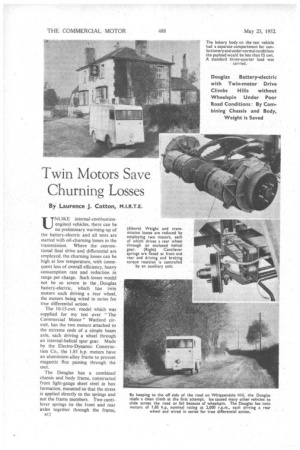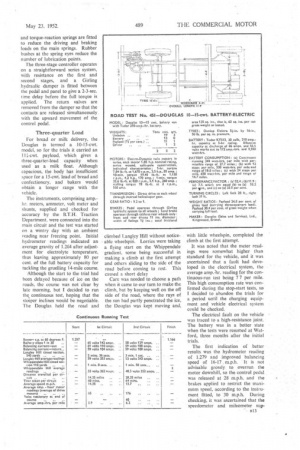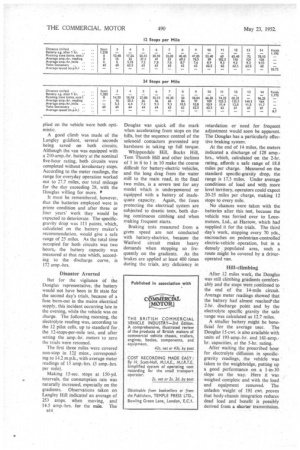Twin Motors Save Churning Losses
Page 46

Page 47

Page 48

If you've noticed an error in this article please click here to report it so we can fix it.
By Laurence J. Cotton, M.I.R.T.E.
UN L I KE internal -com bustion engined vehicles, there can be no preliminary warming-up of the battery-electric and all tests are started with oil-churning losses in the transmission. Where the conventional final drive arid differential are employed, the churning losses can he high at low temperature, with consequent loss of overall efficiency, heavy consumption rate and reduction in range per charge. Such losses would not be so severe in the , Douglas battery-electric, which has twin motors each driving a rear wheel, the motors being wired in series for true differential action.
The 10-15-cwt. model which was supplied for my test over "The Commercial Motor" Watford circuit, has the two motors attached to the extreme ends of a simple beam axle, each driving a wheel through an internal-helical spur gear. Made by the Electro-Dynamic Construction Co., the 1.85 h.p. motors have an aluminium-alloy frame to prevent magnetic flux passing through the unit.
The Douglas has a combined chassis and body frame, constructed from light-gauge sheet steel in box formation, mounted so that the stress is applied directly to the springs and not the frame members. Two cantilever springs tie the front and rear axles together through the frame, and torque-reaction springs are fitted to reduce the driving and braking loads on the main springs. Rubber bushes at the spring eyes reduce the number of lubrication points.
The three-stage controller operates on a straightforward series system, with resistance on the first and second stages, and a Girling hydraulic damper is fitted between the pedal and panel to give a 2-3-see. time delay before the full torque is applied. The return valves are removed from the damper so that the contacts are released simultaneously. with the upward movement of the control pedal. • Three-quarter Load
For bread or milk delivery, the Douglas is termed a I0-15-cwt. model, so for the trials it carried an 1 Li-cwt. payload, which gives a three-quarter-load capacity when used as a milk float. Although capacious, the body has insufficient space for a 15-cwt. load of bread and confectionery, and bakers would obtain a longer range with the vehicle.
The instruments, comprising amp.hr. meters, ammeter, volt meter and shunts, supplied and checked for accuracy by the B.T.H. Traction Department, were connected into the main circuit and the test was started on a wintry day with an ambient reading near freezing point. Initial hydrometer readings indicated an average gravity of 1.264 after adjustment for electrolyte temperature, thus leaving approximately 80 per cent. of the full battery capacity for tackling the gruelling 14-mile course.
Although the start to the trial had been delayed because of ice on the roads, the course was not clear by late morning, but I decided to run the continuous test, hoping that the steeper inclines would be negotiable. The Douglas held the road and climbed Langley Hill without noticeable wheelspin. Lorries were taking a flying start on the Whippendale gradient, some being successful in making a climb at the first attempt and others sliding to the side of the road before coming to rest. This caused a short delay Care was needed to choose a path when it came to our turn to make the climb, but by keeping well on the off side of the road, where the rays of the sun had partly penetrated the ice, the Douglas was kept moving and, with little wheelspin, completed the climb at the first attempt.
It was noted that the meter readings were somewhat higher than standard for the vehicle, and it was ascertained that a fault had developed in the electrical system, the average amp.-hr. reading for the continuous-run test being 7 7 per mile. This high‘consumption rate was confirmed during the stop-start tests, so I decided to abandon the trials for a period until the charging equipment and vehicle electrical system could be checked.
The electrical fault on the vehicle was traced to a high-resistance joint. The battery was in a better state when the tests were resumed at Watford, three months after the initial trials.
The first indication of better results was the hydrometer reading of 1.279 and improved balancing speed of 16-17. m.p.h. It is not advisable grossly to overrun the motor downhill, so the control pedal was released at 28 m.p.h. and the brakes applied to restrict the maximum speed, according to the instrument fitted, to 30 m.p.h. During checking, it was ascertained that the speedometer and mileometer sup
plied on the vehicle were both optimistic.
A good climb was made of the Langley gradient, several seconds being saved on both circuits. Although the van was equipped with a 210-amp.-hr. battery at the nominal five-hour rating, both circuits were completed without involuntary stops. According to the meter readings, the range for everyday operation worked out to 27.7 miles, our total mileage for the day exceeding 28, with the Douglas willing for more.
It must be remembered, however, that the batteries employed were in prime condition and after three or four years' work they would be expected to deteriorate. The specificgravity drop was 113 points, which, calculated on the battery maker's recommendation, would give a safe range of 25 miles. As the total time Occupied for both circuits was two hours, the battery capacity was measured at that rate which, according to the discharge curve, is 172 amp.-hrs.
Disaster Averted
But for the vigilance of the Douglas representative, the battery would not have been in fit state for the second day's trials, because of a fuse burn-out in the mains electrical supply, this incident occurring late in the evening, while the vehicle was on charge. The following morning, the electrolyte reading was, according to the 12 pilot cells, up to standard for the 12-stops-per-mile test, and after setting the amp.-hr. meters to zero the trials were resumed.
The first three miles were covered non-stop in 12i mins., corresponding to 14.2 m.p.h., with average meter readings of 15 amp.-hrs. (5 amp.-hrs. per mile).
Making 15-sec. stops at 150-yd. intervals, the consumption rate was naturally increased, especially on the gradients. Observations taken on Langley Hill indicated an average of 253 amps. when moving, and 14.5 amp.-hrs. for the mile. The
B14 Douglas was quick off the mark when accelerating from stops on the hills, but the sequence control of the solenoid contactors prevented any harshness in taking up full torque.
Whippendale Hill, Bucks Hill, Tom Thumb Hill and other inclines of 1 in 6 to 1 in 10 make the course difficult for battery-electric vehicles, and the long drag from the water mill to the main road, in the final two miles, is a severe test for any model which is underpowered or equipped with a battery of inadequate capacity. Again, the fuses protecting the electrical system are subjected to drastic tests, both during continuous cimbing and when making frequent starts.
Braking tests measured from a given speed are not conducted with battery-electrics, because the Watford circuit makes heavy demands when stopping so frequently on the gradients. As the brakes are applied at least 400 times during the trials, any deficiency in
retardation or need for frequent adjustment would soon be apparent. The Douglas has a particularly effective braking system.
At the end of 14 miles, the meters indicated a discharge of 128 amp.hrs., which, calculated on the 2-hr. rating, affords a safe range of 18.8 miles per charge. Measured on the standard specific-gravity drop, the range is 17.3 miles. Under average conditions of load and with more level territory, operators could expect 20-25 miles per charge, making 12 stops to every mile.
No chances were taken with the batteries after this test, because the vehicle was ferried over to Locomotors, Ltd., at Harrow, which had supplied it for the trials. The third day's work, stopping every 70 yds., encroaches on pedestrian-controlled' electric-vehicle operation, but in a densely populated area, such a route might be covered by a driveroperated van.
Hill-climbing
After 12 miles work, the Douglas was still climbing gradients comfortably and the stops were continued to the end of the 14-mile circuit. Average meter readings showed that the battery had almost reachedh the 2-hr. discharge point and by the electrolyte specific gravity the safe range was calculated as 12.7 miles.
A smaller battery might be beneficial for the average user. The Douglas 15-cwt. is also available with units of 193-amp.-hr. and 161-amp.hr. capacities, at the 5-hr. rating.
After waiting the prescribed hour for electrolyte diffusion in specificgravity readings, the vehicle was taken to the weighbridge, putting up a good performance on a 1-in-30 slope on the way. Here it was weighed complete and with the load and equipment removed. The unladen weight of 191 cwt. proves that body-chassis integration reduces dead load and benefit is possibly derived from a shorter transmission.




















































































